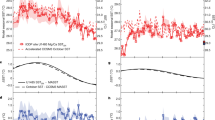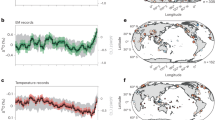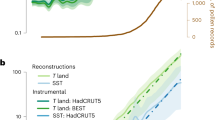Abstract
During the late Miocene epoch, about seven million years ago, large areas of the continents experienced drying, enhanced seasonality, and a restructuring of terrestrial plant and animal communities. These changes are seen throughout the subtropics, but have typically been attributed to regional tectonic forcing. Here we present a set of globally distributed sea surface temperature records spanning the past 12 million years based on the alkenone unsaturation method. We find that a sustained late Miocene cooling occurred synchronously in both hemispheres, and culminated with ocean temperatures dipping to near-modern values between about 7 and 5.4 million years ago. The period of maximum cooling coincides with evidence for transient glaciations in the Northern Hemisphere and with a steepening of the pole-to-equator temperature gradient, as well. We thus infer that late Miocene aridity and terrestrial ecosystem changes occurred in a global context of increasing meridional temperature gradients. We conclude that a global forcing mechanism, such as the previously hypothesized decline in atmospheric CO2 levels between eight and six million years ago, is required to explain the late Miocene changes in temperature, climate and ecosystems.
This is a preview of subscription content, access via your institution
Access options
Subscribe to this journal
Receive 12 print issues and online access
$259.00 per year
only $21.58 per issue
Buy this article
- Purchase on Springer Link
- Instant access to full article PDF
Prices may be subject to local taxes which are calculated during checkout



Similar content being viewed by others
References
Schuster, M. et al. The age of the Sahara desert. Science 311, 821 (2006).
Dupont, L. M., Rommerskirchen, F., Mollenhauer, G. & Schefuß, E. Miocene to Pliocene changes in South African hydrology and vegetation in relation to the expansion of C4 plants. Earth Planet. Sci. Lett. 375, 408–417 (2013).
Arakaki, M. et al. Contemporaneous and recent radiations of the world’s major succulent plant lineages. Proc. Natl Acad. Sci. USA 108, 8379–8384 (2011).
Ehleringer, J. R., Cerling, T. E. & Helliker, B. R. C4 photosynthesis, atmospheric CO2 and climate. Oecologia 112, 285–299 (1997).
Cerling, T. E. et al. Global vegetation change through the Miocene/Pliocene boundary. Nature 389, 153–158 (1997).
Strömberg, C. A. Evolution of grasses and grassland ecosystems. Annu. Rev. Earth Planet. Sci. 39, 517–544 (2011).
Wang, Y., Cerling, T. E. & MacFadden, B. J. Fossile horses and carbon isotopes: new evidence for Cenozoic dietary, habitat, and ecosystem changes in North America. Palaeogeogr. Palaeoclimatol. Palaeoecol. 107, 269–279 (1994).
Badgley, C. et al. Ecological changes in Miocene mammalian record show impact of prolonged climatic forcing. Proc. Natl Acad. Sci. USA 105, 12145–12149 (2008).
Brunet, M. Two new Mio-Pliocene Chadian hominids enlighten Charles Darwin’s 1871 prediction. Phil. Trans. R. Soc. B 365, 3315–3321 (2010).
Lewis, A. R. et al. Mid-Miocene cooling and the extinction of tundra in continental Antarctica. Proc. Natl Acad. Sci. USA 105, 10676–10680 (2008).
Zachos, J., Pagani, M., Sloan, L. C., Thomas, E. & Billups, K. Trends, rhythms, and aberrations in global climate 65 Ma to present. Science 292, 686–693 (2001).
Cramer, B., Toggweiler, J. R., Wright, J. D., Katz, M. E. & Miller, K. G. Ocean overturning since the late Cretaceous: inferences from a new benthic foraminiferal isotope compliation. Paleoceanography 24, PA4216 (2009).
Beerling, D. J. & Royer, D. L. Convergent Cenozoic CO2 history. Nat. Geosci. 4, 418–420 (2011).
Müller, P. J., Kirst, G., Ruhland, G., von Storch, I. & Rosell-Melé, A. Calibration of the alkenone paleotemperature index on core-tops from the eastern South Atlantic and the global ocean (60° N–60° S). Geochem. Cosmochim. Acta 62, 1757–1772 (1998).
Zhang, Y. G., Pagani, M. & Liu, Z. A 12-million-year temperature history of the tropical Pacific Ocean. Science 344, 84–87 (2014).
DeConto, R. M. et al. Thresholds for Cenozoic bipolar glaciation. Nature 455, 652–656 (2008).
Larsen, H. C. et al. Seven million years of glaciation in Greenland. Science 264, 952–955 (1994).
Bradshaw, C. D. et al. The relative roles of CO2 and palaeogeography in determining late Miocene climate: results from a terrestrial model-data comparison. Clim. Past 8, 715–786 (2012).
Hodell, D. A., Curtis, J. H., Sierro, F. J. & Raymo, M. E. Correlation of late Miocene to early Pliocene sequences between the Mediterranean and North Atlantic. Paleoceanography 16, 164–178 (2001).
Krissek, L. in Proceeding of the Ocean Drilling Program, Scientific Results (eds Rea, D. K., Basov, L. A., Scholl, D. W. & Allan, J. F.) 179–194 (Ocean Drilling Program, 1992).
Mercer, J. H. & Sutter, J. F. Late Miocene-earliest Pliocene glaciation in southern Argentina: implications for global ice-sheet history. Palaeogeogr. Palaeoclimatol. Palaeoecol. 38, 185–206 (1982).
Williams, T. et al. Evidence for iceberg armadas from east Antarctica in the Southern Ocean during the late Miocene and early Pliocene. Earth Planet. Sci. Lett. 290, 351–361 (2010).
Kennett, J. P. & Barker, P. F. Latest Cretaceous to Cenozoic climate and oceanographic developments in the Weddell Sea, Antarctica: an ocean-drilling perspective. Proc. Ocean Drilling Program, Scientific Results 937–960 (Ocean Drilling Program, 1990).
Thiede, J. et al. Late Cenozoic history of the polar North Atlantic: results from ocean drilling. Quat. Sci. Rev. 17, 185–208 (1998).
Brierley, C. M. et al. Greatly expanded tropical warm pool and weakened Hadley circulation in the early Pliocene. Science 323, 1714–1718 (2009).
Pound, M. J. et al. A Tortonian (late Miocene 11.61–7.25 Ma) global vegetation reconstruction. Palaeogeogr. Palaeoclimatol. Palaeoecol. 300, 29–45 (2011).
Diester-Haass, L., Billiups, K. & Emeis, K. C. Late Miocene carbon isotope records and marine biological productivity: was there a (dusty) link? Paleoceanography 21, PA4216 (2006).
Lunt, D. J. et al. Earth system sensitivity inferred from Pliocene modelling and data. Nat. Geosci. 3, 60–64 (2009).
Hodell, D. A. & Venz-Curtis, K. A. Late Neogene history of deepwater ventilation in the Southern Ocean. Geochem. Geophys. Geosyst. 7, Q09001 (2006).
Quade, J. & Cerling, T. E. Expansion of C4 grasses in the late Miocene of Northern Pakistan: evidence from stable isotopes in paleosols. Palaeogeogr. Palaeoclimatol. Palaeoecol. 115, 91–116 (1995).
Zhang, Z. et al. Aridification of the Sahara desert caused by Tethys Sea shrinkage during the late Miocene. Nature 513, 401–404 (2014).
LaRiviere, J. P. et al. Late Miocene decoupling of oceanic warmth and atmospheric carbon dioxide forcing. Nature 486, 97–100 (2012).
Bolton, C. T. & Stoll, H. M. Late Miocene threshold response of marine algae to carbon dioxide limitation. Nature 500, 558–562 (2013).
Huang, Y., Clemens, S. C., Liu, W., Wang, Y. & Prell, W. L. Large-scale hydrological change drove the late Miocene C4 plant expansion in the Himalayan foreland and Arabian Peninsula. Geology 35, 531–534 (2007).
Herbert, T. D., Cleaveland Peterson, L., Lawrence, K. T. & Liu, Z. Tropical ocean temperature over the past 3.5 million years. Science 328, 1530–1534 (2010).
Liu, Z. & Herbert, T. D. High-latitude influence on the eastern equatorial Pacific climate in the early Pleistocene epoch. Nature 427, 720–723 (2004).
Lawrence, K. T., Liu, Z. & Herbert, T. D. Evolution of the eastern tropical Pacific through Plio-Pleistocene glaciation. Science 312, 79–83 (2006).
Lawrence, K. T., Herbert, T. D., Brown, C. M., Raymo, M. E. & Haywood, A. M. High-amplitude variations in North Atlantic sea surface temperature during the early Pliocene warm period. Paleoceanography 24, PA2218 (2009).
Rommerskirchen, F., Condon, T., Mollenhauer, G., Dupont, L. M. & Schefuss, E. Miocene to Pliocene development of surface and subsurface temperatures in the Benguela Current system. Paleoceanography 26, PA3216 (2011).
Seki, O. et al. Paleoceanographic changes in the Eastern Equatorial Pacific over the last 10 Myr. Paleoceanography 27, PA3224 (2012).
Rousselle, G., Beltran, C., Sicre, M. A., Raffi, I. & De Rafelis, M. Sea-surface condition changes in the Equatorial Pacific during the Mio-Pliocene as inferred from coccolith geochemistry. Earth Planet. Sci. Lett. 361, 412–421 (2013).
Tzanova, A., Herbert, T. D. & Cleaveland Peterson, L. C. Cooling Mediterranean Sea Surface Temperatures during the late Miocene provide a climate context for evolutionary transitions in Africa and Eurasian flora and fauna. Earth Planet. Sci. Lett. 419, 71–80 (2015).
Herbert, T. D., Peterson, L. C. & Ng, G. Evolution of Mediterranean sea surface temperatures 3.5-1.5 Ma: regional and hemispheric influences. Earth Planet. Sci. Lett. 409, 307–318 (2015).
Emeis, K.-C. et al. Temperature and salinity variations of Mediterranean Sea surface waters over the last 16,000 years from records of planktonic stable oxygen isotopes and alkenone unsaturation ratios. Palaeogeogr. Palaeoclimatol. Palaeoecol. 158, 259–280 (2000).
Emeis, K.-C. et al. Eastern Mediterranean surface water temperatures and δ18O composition during deposition of sapropels in the late Quaternary. Paleoceanography 18, 1005 (2003).
Fedorov, A. V., Burls, N., Lawrence, K. & Peterson, L. Tightly linked ocean zonal and meridional temperature gradients over geological timescales. Nat. Geosci. 8, 975–980 (2015).
Rosell-Melé, A. & Prahl, F. G. Seasonality of temperature estimates as inferred from sediment trap data. Quat. Sci. Rev. 72, 128–136 (2013).
Prahl, F. G., Muehlhausen, L. A. & Zahnle, D. L. Further evaluation of long-chain alkenones as indicators of paleoceanographic conditions. Geochim. Cosmochim. Acta 52, 2303–2310 (1988).
Blaauw, M. & Christen, J. A. Flexible paleoclimate age-depth models using an autoregressive gamma process. Bayesian Anal. 6, 457–474 (2011).
Gradstein, F. M., Ogg, G. & Schmitz, M. The Geologic Time Scale 2012 2-Volume Set (Elsevier, 2012).
NODC_WOA98 (NOAA/OAR/ESRL PSD, 1998); http://www.esrl.noaa.gov/psd
Seton, M. et al. Global continental and ocean basin reconstructions since 200 Ma. Earth Sci. Rev. 113, 212–270 (2012).
Wessel, P. & Smith, W. H. F. A global, self-consistent, hierarchical, high-resolution shoreline database. J. Geophys. Res. 101, 8741–8743 (1996).
Lear, C. H., Rosenthal, Y. & Wright, J. D. The closing of a seaway: ocean water masses and global climate change. Earth Planet. Sci. Lett. 210, 425–436 (2003).
Rea, D. K., Snoeckx, H. & Joseph, L. H. Late Cenozoic eolian deposition in the North Pacific: Asian drying, Tibetan uplift, and cooling of the Northern Hemisphere. Paleoceanography 13, 215–224 (1998).
Molnar, P. Mio-Pliocene growth of the Tibetan Plateau and evolution of East Asian climate. Palaeontol. Electron. 8, 1–23 (2005).
Ruddiman, W. F. et al. Late Miocene to Pleistocene evolution of climate in Africa and the low-latitude Atlantic: overview of Leg 108 results. in Proceeding of the Ocean Drilling Program, Scientific Results (eds Ruddiman, W. F., Sarnthein, M., Baldaufand, J. G. & Heath, R.) 463–482 (Ocean Drilling Program, 1989).
Tipple, B. J. & Pagani, M. The early origins of terrestrial C4 photosynthesis. Annu. Rev. Earth Planet. Sci. 35, 435–461 (2007).
Seki, O. et al. Alkenone and boron-based Pliocene pCO2 records. Earth Planet. Sci. Lett. 292, 201–211 (2010).
Zhang, Y. G., Pagani, M., Liu, Z., Bohaty, S. & DeConto, R. A 40-million-year history of atmospheric CO2 . Phil. Trans. R. Soc. A 371, 20130146 (2013).
Bartoli, G., Hoenisch, B. & Zeebe, R. E. Atmospheric CO2 decline during the Pliocene intensification of Northern Hemisphere Glaciation. Paleoceanography 26, PA4213 (2011).
Martinez-Boti, M. A. et al. Plio-Pleistocene climate sensitivity evaluated using high-resolution CO2 records. Nature 518 (2015).
Foster, G. L., Lear, C. H. & Rae, J. W. B. The evolution of pCO2, ice volume and climate during the middle Miocene. Earth Planet. Sci. Lett. 341–344, 243–254 (2012).
Acknowledgements
Portions of this work were funded by the Petroleum Research Fund of the American Chemical Society, by the Evolving Earth Foundation, and by NSF grants to T.D.H., K.T.L. and L.C.P. (0623487, 1304366, 1459280, and 1545859). We thank D. Muller, J. Cannon and M. Seton for help with GPlates backtracking software, A. Alpert and A. Martin for laboratory analyses, C. Riihimaki for assistance in creating Fig. 1 and J.-E. Lee, S. C. Clemens, C. Janis and C. Bolton for comments on earlier drafts. We gratefully acknowledge assistance by the curators for the IODP
Author information
Authors and Affiliations
Contributions
T.D.H. and K.T.L. conceived the idea of a global synthesis of late Miocene SST estimates based on the alkenone method and wrote the majority of the text. K.T.L., L.C.P., C.S.K., R.C.-G. and A.T. provided primary data based on their laboratory work, and contributed to the analysis and the text. K.T.L. produced the figures.
Corresponding author
Ethics declarations
Competing interests
The authors declare no competing financial interests.
Supplementary information
Supplementary Information
Supplementary Information (PDF 289 kb)
Supplementary Information
Supplementary Information (XLSX 42 kb)
Supplementary Information
Supplementary Information (XLS 2667 kb)
Supplementary Information
Supplementary Information (XLSX 82 kb)
Supplementary Information
Supplementary Information (XLSX 77 kb)
Supplementary Information
Supplementary Information (XLS 496 kb)
Supplementary Information
Supplementary Information (TXT 4 kb)
Rights and permissions
About this article
Cite this article
Herbert, T., Lawrence, K., Tzanova, A. et al. Late Miocene global cooling and the rise of modern ecosystems. Nature Geosci 9, 843–847 (2016). https://doi.org/10.1038/ngeo2813
Received:
Accepted:
Published:
Issue Date:
DOI: https://doi.org/10.1038/ngeo2813
This article is cited by
-
Late Miocene onset of the modern Antarctic Circumpolar Current
Nature Geoscience (2024)
-
The influence of subpolar marine ice expansion on global climate in the Early Pleistocene
npj Climate and Atmospheric Science (2024)
-
Paleoclimatic application of spectral parameters to the eolian red clay of the Jianzha Basin, northeastern margin of the Tibetan Plateau
Science China Earth Sciences (2024)
-
History of the terrestrial isopod genus Ligidium in Japan based on phylogeographic analysis
BMC Ecology and Evolution (2023)
-
Global climate forcing on late Miocene establishment of the Pampean aeolian system in South America
Nature Communications (2023)



